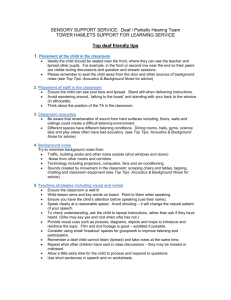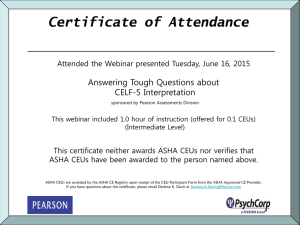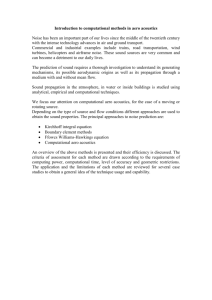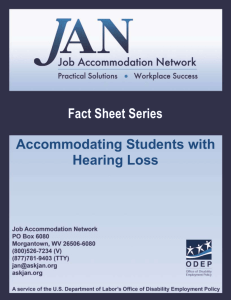classroom noise & acoustics - National Hearing Conservation
advertisement
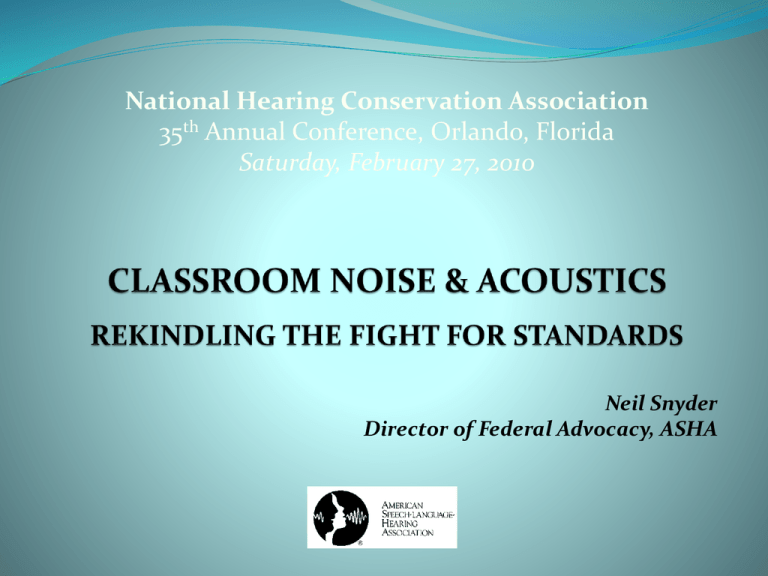
National Hearing Conservation Association 35th Annual Conference, Orlando, Florida Saturday, February 27, 2010 Neil Snyder Director of Federal Advocacy, ASHA History of Classroom Acoustics 30,000-24,000 B.C.E 35,000 BCE: Poor acoustics in caves leads to limited brain development in Neanderthal Offspring. Species dies out and replaced by Homo sapiens. The Civil Rights of Acoustics July 2, 1964, The Civil Rights Act of 1964 (P.L. 88-352) is signed in to law by President Lyndon Johnson 1975, the Education for All Handicapped Children Act is passed in to law On July 26th, 1990, President George H.W. Bush signs the Americans with Disabilities Act of 1990 (ADA)(P.L. 101-336) in to law Recent History In 1998, the U.S. Access Board joins with the Acoustical Society of America (ASA) to support the development of a national classroom acoustics standard. Stakeholders from both public and private sectors were involved 2002, ASA/ANSI working group completes work and publishes, “S12.60-2002, Acoustical Performance Criteria, Design Requirements and Guidelines for Schools” The Fire For National Standards Begins Again July 12, 2007, Congressman Ben Chandler introduces H.R. 3021, the 21st Century Green High- Performing Public School Facilities Act It requires the Secretary of Education to make grants to states for the modernization, renovation, or repair of public schools, including public charter schools, to make them safe, healthy, highperforming, and technologically up-to-date 21st Century Green High-Performing Public School Facilities Act May 8, 2008, House Education and Labor Committee passes H.R. 3021 May, 2008, ASHA member notifies ASHA’s Government Relations and Public Policy unit that H.R.3021 does not reference noise, sound, or acoustics when identifying environmental concerns facing students and educators June 4, 2008, U.S. House of Representatives passes H.R.3021 August 1, 2008, Senate receives H.R.3021, does not act on bill November 21, 2008, U.S. Access Board convenes a “stakeholders roundtable” to, “explore ways of improving acoustics in classrooms.” ASHA staff attends President Barack Obama February 4, 2009, During the signing ceremony on a law expanding the State Children’s Health Insurance Program (SCHIP) President Barak Obama stated that: “No child in America should be receiving her primary care in the emergency room in the middle of the night. No child should be falling behind at school because he can’t hear the teacher or see the blackboard. I refuse to accept that millions of our kids fail to reach their full potential because we fail to meet their basic needs. In a decent society, there are certain obligations that are not subject to tradeoffs or negotiation – health care for our children is one of those obligations.” th 111 Congress, st 1 Session April 30, 2009, Congressman Chandler re-introduces the 21st Century Green High-Performing Public School Facilities Act, now numbered H.R.2187 ASHA advocates for and gains the inclusion of “noise” in the new bill. H.R.2187, if passed in to law, would provide grants to states and local school districts to, among other things, take, “measures designed to reduce or eliminate human exposure to classroom noise and environmental noise pollution” House Consideration of H.R.2187 May 11-14, 2009 House Education and Labor then full U.S. House of Representatives considers and passes H.R.2187. Sends bill to Senate. ASHA’s Advocacy ASHA asks for and gets language included in the narrative report on H.R.2187 that elaborates upon the noise provision by stating that: “The Committee encourages school districts that undertake projects to reduce or eliminate human exposure to classroom noise and environmental noise pollution, and the Secretary, in providing technical assistance concerning reducing background noise and reverberation in classrooms, to consider the American National Standards Institute (ANSI) approved Standard S12.60- 2002, [Acoustical Performance Criteria, Design Requirements, and Guidelines for School].” ASHA Brings Some Noise to Capitol Hill May 15, 2009, ASHA sponsors congressional briefing on Capitol Hill regarding classroom noise and acoustics. Things Get Strange on Capitol Hill “If you love the law and you love good sausage, don’t watch either of them being made.” -Betty Talmadge, The Reader, November 25, 1977 School Construction + Student Aid= Health Care Reform? July 15, 2009, Congressman George Miller, Chairman of the House Education and Labor Committee introduces H.R.3221, a bill focused upon reorganizing federal student aid programs and incorporates the text of H.R.2187, the Green Schools bill Congressional leaders also designate H.R.3221 as a potential “budget reconciliation” vehicle which would be used to ram health care reform legislation through the Senate September 17, 2009, House passes H.R.3221 September 22, 2009, Senate receives H.R3221, no further action Revising the ANSI Standard (A Run at the U.S. Building Code) September 30, 2009, The U.S. Access Board, Acoustical Society of America, the American National Standards Institute have the first meeting of the reconstituted working group “S12/WG52” to reaffirm the redrafted S.12.60-2002 so that it can be submitted to the International Code Council in May, 2010. Revised Standard Not Ready for Prime Time November 11, 2009, The U.S. Access Board proposes an amendment to the International Building Code requiring school buildings to meet the standards defined in S.12.60-2002 The Access Board then requests that the Code Council “disapproves” of the code change since the process to revise the standard in not complete This preserves the Board’s ability to re-submit the code change during the Code Council’s subsequent meeting in Dallas, Texas, in May of 2010 What You Can Do: Nationally Advocate to Congress for the inclusion of funds to address noisy classrooms in any school construction legislation Track the International Code Council meeting and/or register to testify at their May, 2010, meeting. Build or join a network, such as the Classroom Noise & Acoustics Coalition, on Facebook What You Can Do Within Your State Advocate for your state to adopt the ANSI standard for their school construction policies Identify your state’s school construction policies and building codes Contact the code inspectors association or society What You Can Do Locally Meet with your school district, determine their noise and construction policies, react accordingly Meet with the local PTA or similar organization. They often support efforts to amplify classrooms. Educate them about the determents of amplification before reducing background noise and reverberation Contact Information Neil Snyder Director of Federal Advocacy 444 North Capitol Street, N.W. Suite 715 Washington, D.C. 20001 (202) 624-7750 nsnyder@asha.org Useful Web Resources ASHA’s Classroom Acoustics Page: http://www.asha.org/public/hearing/classroom.htm U.S. Access Board http://www.access-board.gov/acoustic/ Classroom Noise and Acoustics Coalition (Facebook) http://www.facebook.com/home.php?#!/pages/ClassroomNoise-and-Acoustics-Coalition/229124785960?ref=ts International Code Council http://www.iccsafe.org/Pages/default.aspx
